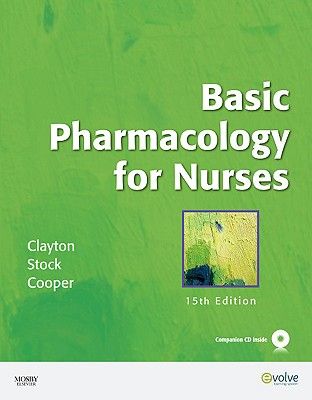Basic Pharmacology for Nurses

Subject
- Nursing--Pharmacology
- Pharmacology
- Pharmacology -- Nurses' Instruction
Plot
Basic Pharmacology for Nurses, 15th edition, is a contemporary classic nursing pharmacology textbook known for its impeccably accurate drug content and its practical applications of the nursing process. A consistent emphasis on health promotion through medication monitoring and patient education is a hallmark of the book. Introductory units ground the reader in basic principles of pharmacology and medication administration, and subsequent body-system units apply the nursing process to every major disorder and drug class to promote safe medication administration.Provides an overview of relevant pathophysiology with an application of the nursing process in each drug chapter, followed by an application of the nursing process to each applicable drug class.Covers the pharmacology of all major classes of drugs, emphasizing side effects to expect, side effects to report, drug interactions, and more.Emphasizes patient education and health promotion with easy-to-recognize Patient Education and Health Promotion headings and reproducible Patient Self-Assessment forms.UNIQUE! Each chapter concludes with a 3-part Medication Safety Review that highlights the importance of safe drug administration and provides review and application of key chapter content related to medication safety.Provides need-to-know coverage of herbal therapies and dietary supplements with an Herbal and Dietary Supplement Therapy chapter, plus Herbal Interactions boxes throughout the chapters.UNIQUE! New coverage of drugs for weight management are included in the expanded Nutrition and Weight Management chapter (Chapter 49).Increased emphasis on medication safety prepares nurses to practice more safely in a clinical environment that is both more pressured and more focused than ever on reducing drug errors. The increased emphasis includes Chapter 7: Principles of Medication Administration, do-not-confuse icons, and an icon to signal ISMP's "high alert" drugs.As the focus on pharmacology on the NCLEX continues to increase, chapter-ending Medication Safety Review sections have been refocused into three types of application-level questions, including Dosage Calculation Review Questions, Review Questions for the NCLEX Examination, and Critical Thinking Activities.Evidence-based practice content is now highlighted with a distinctive icon in the margins.The antimicrobial chapter has been broken into three smaller chapters (Antimicrobiotics, Antifungals, Antivirals) resulting in a less overwhelming reading on this topic.Updated coverage of the most recent FDA approvals, withdrawals, and therapeutic uses provide impeccably accurate and current content to ensure safe drug therapy.Updated and streamlined coverage of nursing care with a stronger focus on the need-to-know material helps students focus on the most current, need-to-know content.


 English
English  Nederlands
Nederlands  Deutsch
Deutsch  Français
Français  Español
Español  Magyar
Magyar  српски
српски  Dansk
Dansk  Italiano
Italiano  Svenska
Svenska  Slovenčina
Slovenčina  Português
Português 
